There are about 5000 different species of ladybugs but not all of them have the same food sources or preferences. Different ladybug species have varied diets. Some ladybugs feed on crops and are destructive in their behavior, while many others eat prey and insects that feed on plants, and are therefore of immense benefit to gardens and the crops in them.
Stick around as we explore the different diets that ladybugs eat, where they find their food, and the potential havoc they can wreak or benefits they can bring to your garden depending on the species.
Primary Food Sources For Ladybugs
As a general rule, the main food sources for ladybugs as a family (Coccinellidae) are as follows:
- Aphids
- Whiteflies
- Scale insects (soft scales and armored scales)
- Mites
- Beans (legumes)
- Squash, pumpkin, zucchinis (cucurbits)
- Low acid fruits
- Honeydew
Ladybug Species Generally Fall Into Three Categories
- Predatory species: These are predators that feed on scale insects, mites, Whiteflies, mealybugs, aphids, young caterpillars, larvae, and eggs of other insects.
- Pest species: The main two species are the Mexican Bean Beetle and Squash Beeltes. These are considered pests on farms and gardens and feed on plants and crops such as beans, squash, pumpkins, and zucchinis.
- Innocuous species: This ladybug species munch on mildews and fungi on the leaves of plants.
Ladybug Food sources
Predatory Ladybugs
When most of us think of a classic ladybug that we all know and love, we think of a red or orange ladybug with black spots. These are predatory ladybugs and they are great for your garden because they feed mostly on pests that are feeding on plants in your garden.
Let’s take a closer look at the favorite foods of predatory ladybugs and why they are so beneficial to your garden.
- Aphids
- White Flies
- Scales Insects
- Mites
- Eggs and Larvae
1. Aphids
Aphids are a group of sap-sucking soft-bodied insects also known as plant louse, ant cows, blackfly, or greenfly. They are tiny and about the size of a pinhead. Aphids are a serious plant pest. They transmit plant virus diseases and may stunt plant growth. They cause the deformation of leaves, buds, and flowers.
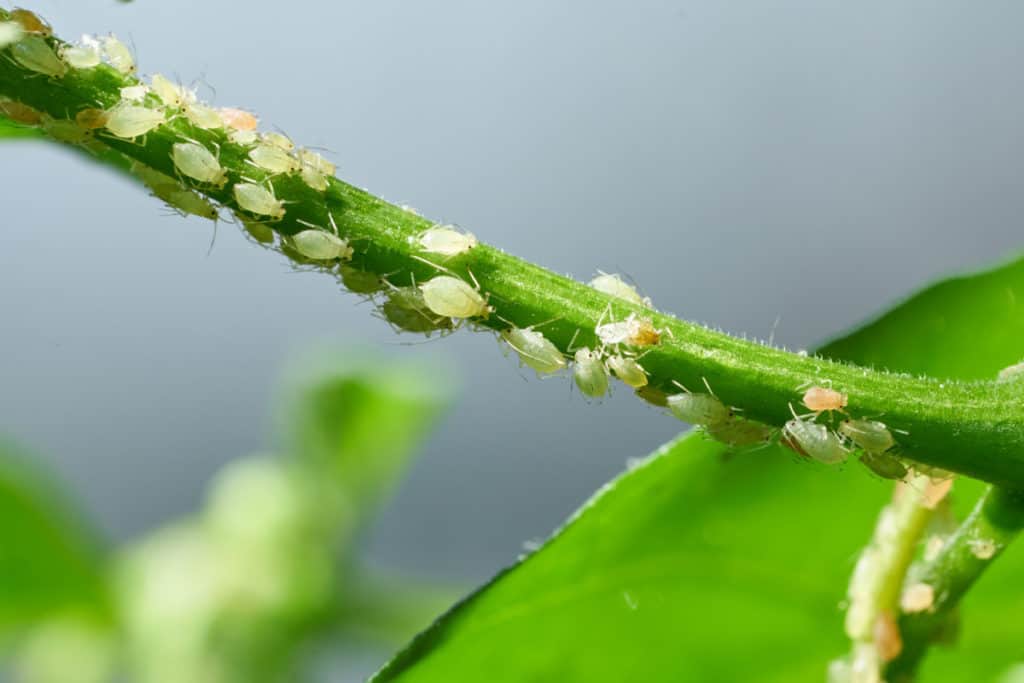
Aphids use their piercing-sucking mouthparts to feed on plant sap. They usually infest the underside of tender leaves and they occur in colonies. Leaves infested heavily can wilt and turn yellow because of excessive sap removal.
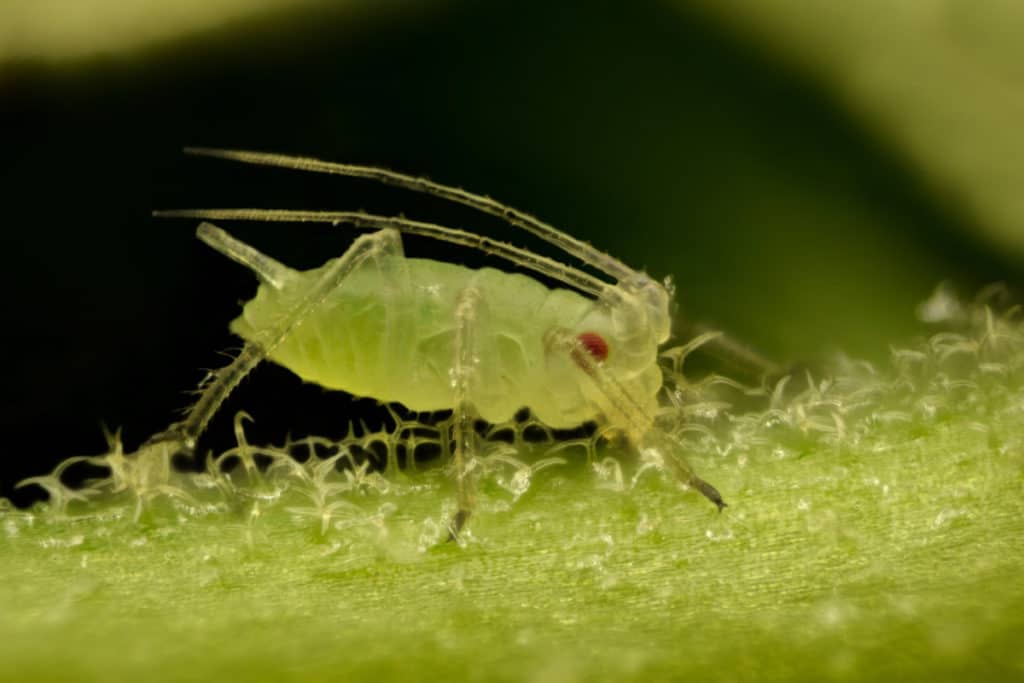
The aphids produce large amounts of “honeydew” which is a sugary liquid waste. Aphids reproduce rapidly and are capable of producing young without mating.
Feeding On: Aphids
Aphids constitute a major part of most predatory ladybug’s diet. These succulent insects are rich in nutrients and sugar from the plant sap on which they feed. An adult ladybug can eat over 50 aphids in a day.
Hippodamia convergens (the convergent lady beetle) is an important species for the biological control of aphids. It is a medium-sized orange and black species that is also sold commercially. This ladybug species has a voracious appetite for aphids
Most ladybugs species voraciously devour aphids because of their succulent nature, abundance and are easy prey.
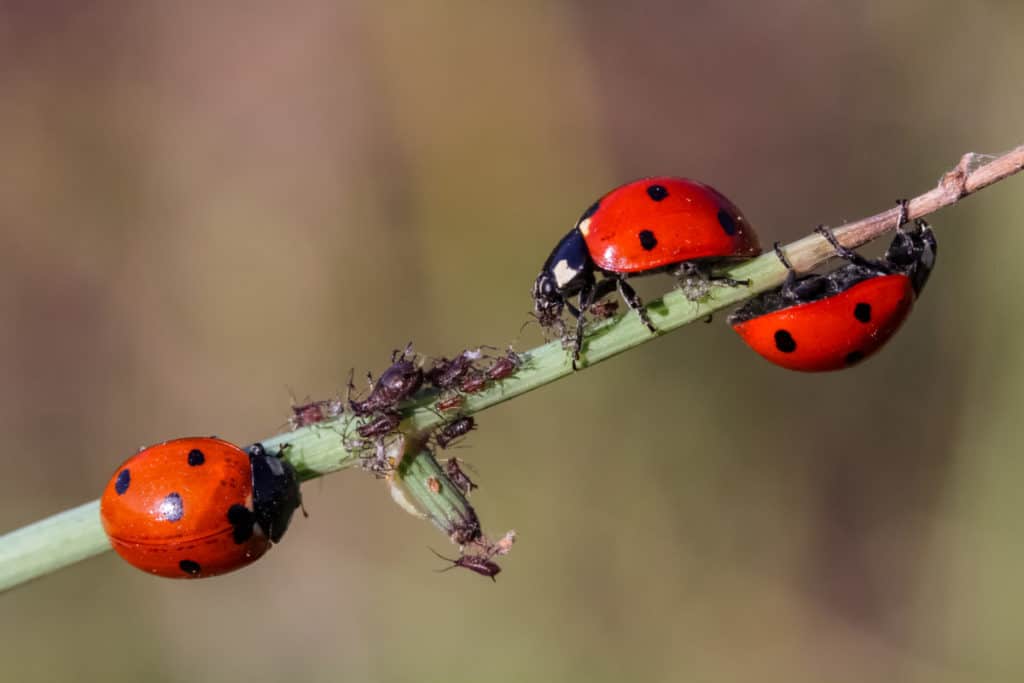
It makes you wonder with ladybugs eating so many aphids a day, do they poop? Sure you would see ladybug poop everywhere? Check out this article we have written for the answers, Do Ladybugs Poop?
2. White flies
Whiteflies are soft-bodied, winged insects closely related to Aphids and mealybugs. They are also commonly known by other names such as citrus whitefly and ash whitefly. Despite the name, they are not true flies.
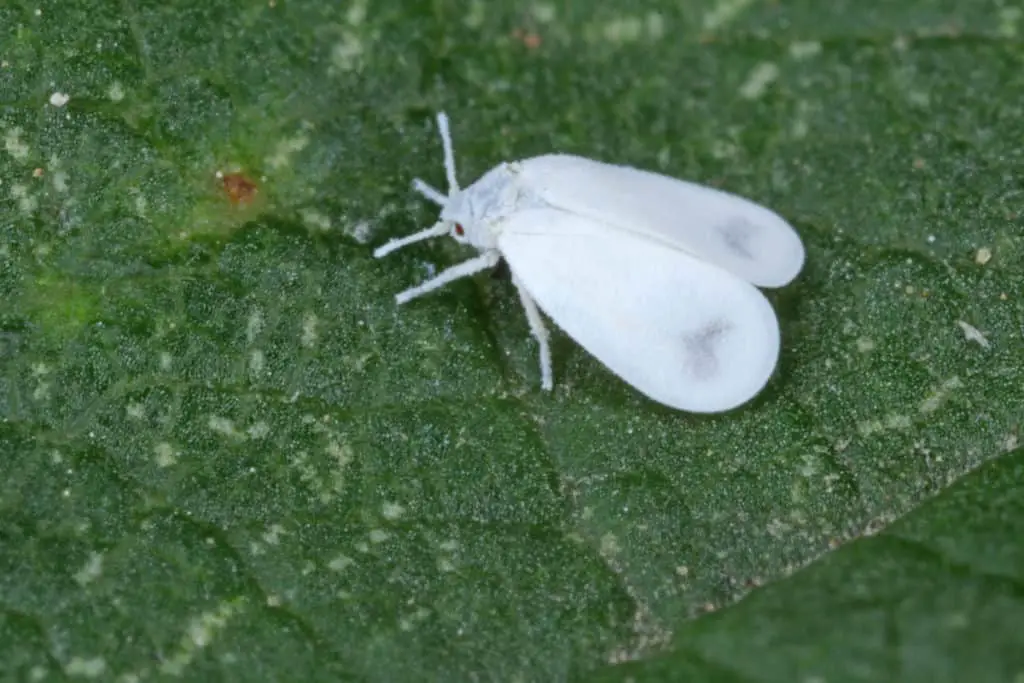
These sap-sucking insects are a major pest in modern agriculture, particularly in open-field farming.
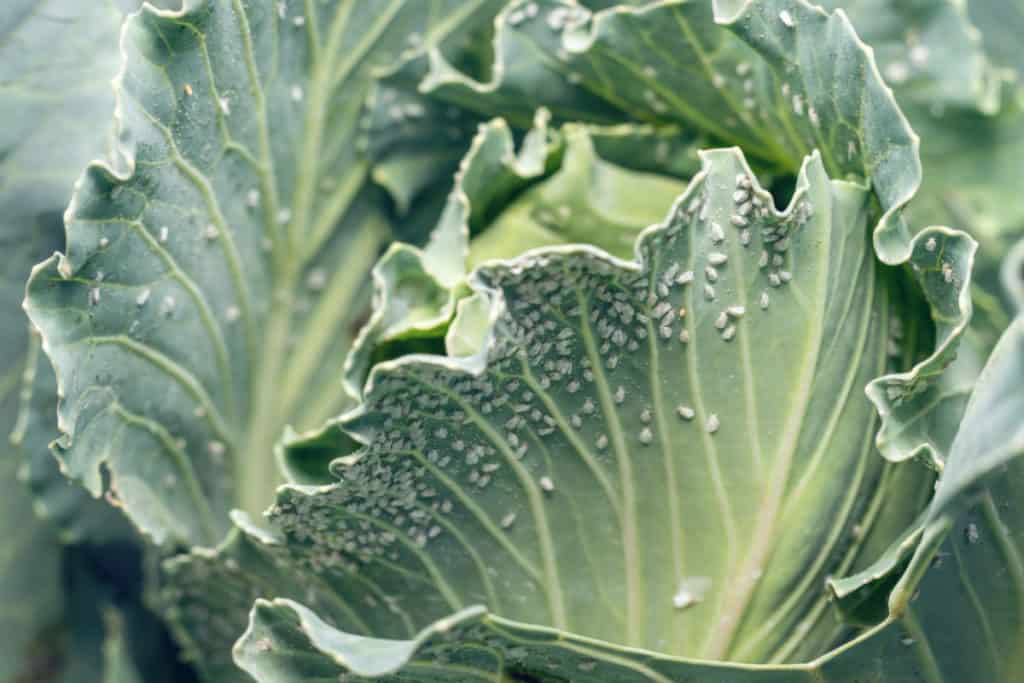
They also secrete large amounts of honeydew because they suck more sap than they can digest. They have piercing mouthparts similar to those of aphids.
They also feed by sucking the phloem (the food conducting tissues) in plant stems and leaves. They make a great meal for most ladybugs because they are also succulent keeping most ladybug species hydrated and nourished.
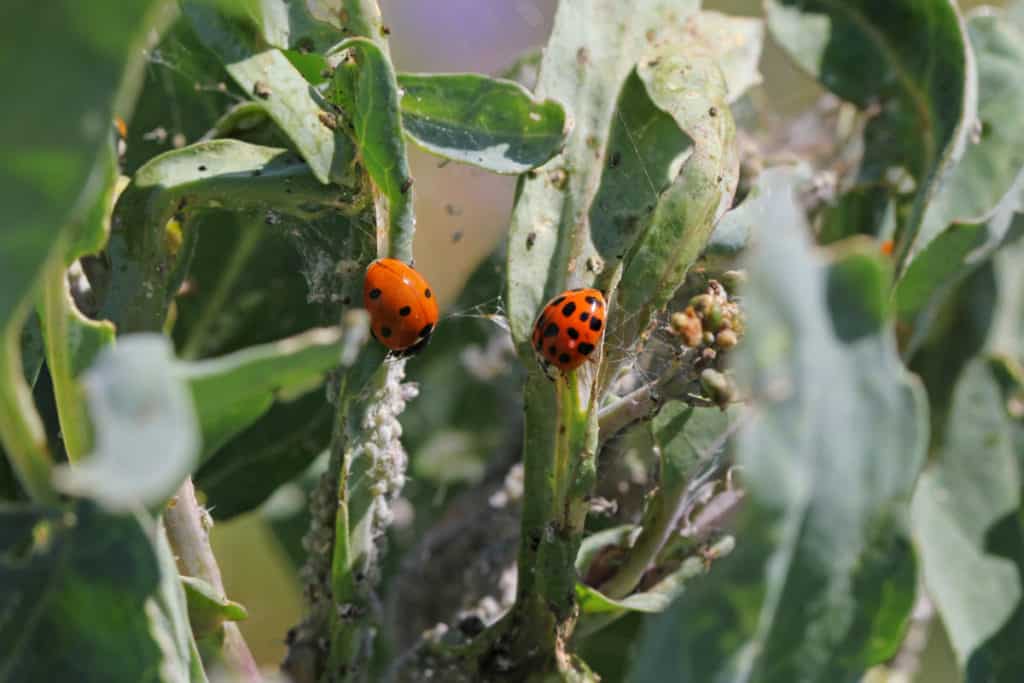
Feeding On : Whiteflies
Among Ladybugs that appear to be specialized predators of whiteflies are:
- Delphastus cataline
- Delphastus pallidus
- Delphastus pussilus
- Nephaspis oculatus
In biological pest control situations, the above-listed ladybugs benefit crop farmers because they keep whiteflies populations under control. They are released into gardens or farms where they feed on whiteflies’ eggs and larvae.
The other small lady beetles that feed on whiteflies are Clitostethus Arcuatus and the Asian multicolored Ladybeetle Harmonia Axyridis. The latter is extremely invasive and has been known to decimate local/native species.
It is also more cannibalistic in behavior than other species and eats many un-hatched eggs and larvae. This could be a possible explanation of why it is such a successful species in establishing itself where it has been introduced to eat aphids as a bio-control solution to pest infestation.
3. Scale Insects
Scale insects are tiny insects that are a menace to plants. They are especially fond of perennial agricultural plants and can cause much damage to nut and fruit trees, forest or plantation trees, greenhouse plants, woody ornamentals, houseplants, and sometimes sugar cane as well as grass lawns.
Because of their small size and inconspicuous habits, most scale insects may not be detected until plant damage is visibly evident and widespread.
Many of the scale insects belong to Diaspididae, Coccidae, and Pseudococcidae. Others that belong to Monophlebidae, Eriococcidae, and Asterolecaniidae are considered to be significant pests. Generally, scale insects may be divided into two categories; armored scales and soft scales.
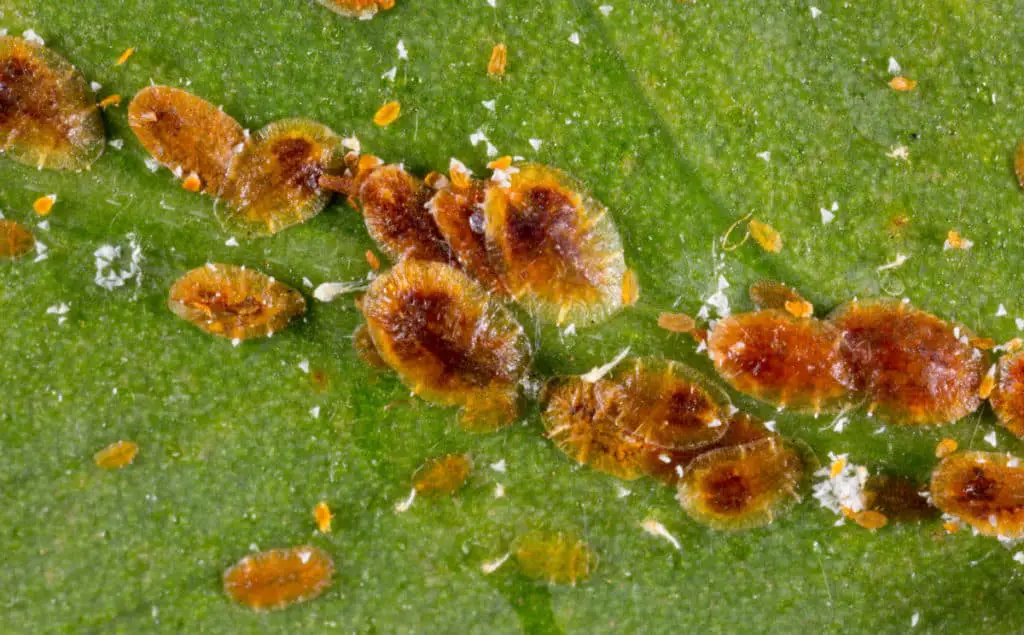
Ladybird beetles (Coccinellidae) are the most important predators of scale insects. The species Ridolia Chilocorus and Cryptolaemus are especially fond of eating scales and are quite effective in pest bio-control.
Feeding On: Soft Scales
Native to Australia, cottony cushion scale is a major pest of citrus and several other woody plants and shrubs such as Acacia, Casuarina, and Pittosporum. The Ladybug Ridolia Chilocorus is a highly effective biological pest control agent for cottony cushion scale.
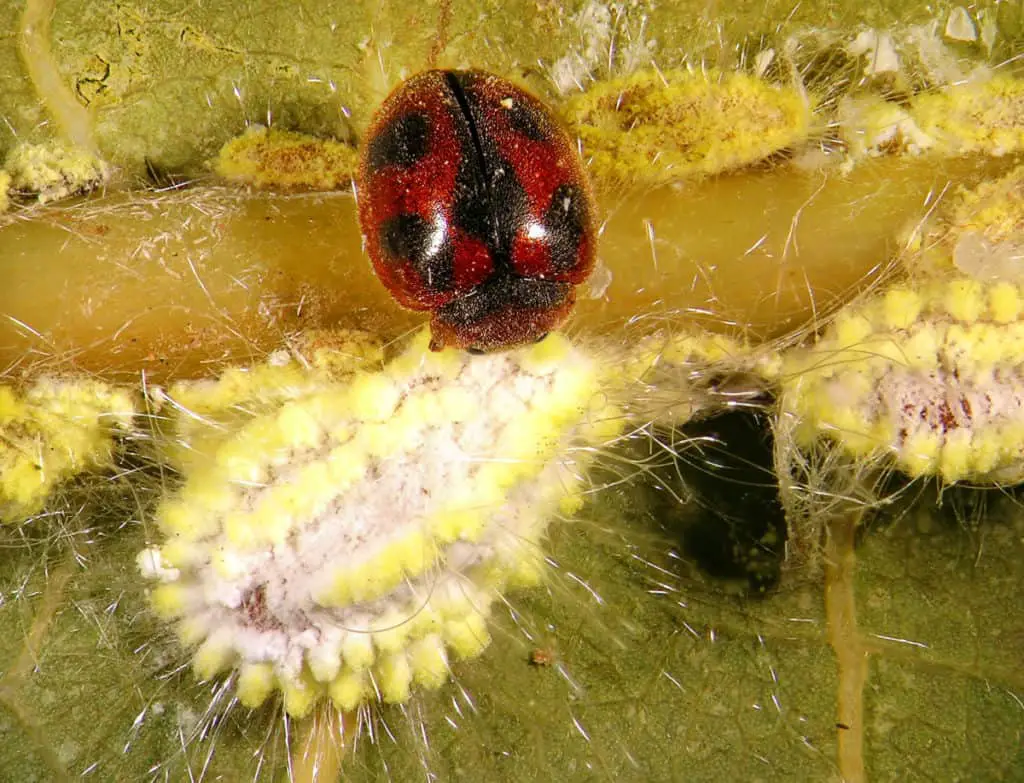
The larvae of Vedalia ladybug species is a specialist predator on a few species of scale Insects known as the giant scales or Monophlebidae.
Feeding On: Armored Scales
One of the most common armored scales you will find in your garden is the mealybug.
The most important ladybug predator of mealybugs is called Cryptolaemus Montrouzieri. It is a native species of Australia and was introduced into California first in 1891 and eventually into Florida. It eats both soft scales (Coccidae) and armored scale insects (Diaspididae).
4. Mites
Mites are relatives of spiders, ticks, and scorpions (Arachnids). Most mites are small in size and can be found in soil as decomposers (they break down humus/plant matter).
Other mites live on plants and sometimes create galls; these are very destructive and are also some of the ones that ladybugs eat.
Mites congregate in large numbers and can quickly overwhelm susceptible plants. Stethorus is a genus of small black ladybugs that are specialized mite destroyers. These ladybug species are considered of significant importance as natural predators of serious pests like spider mites.
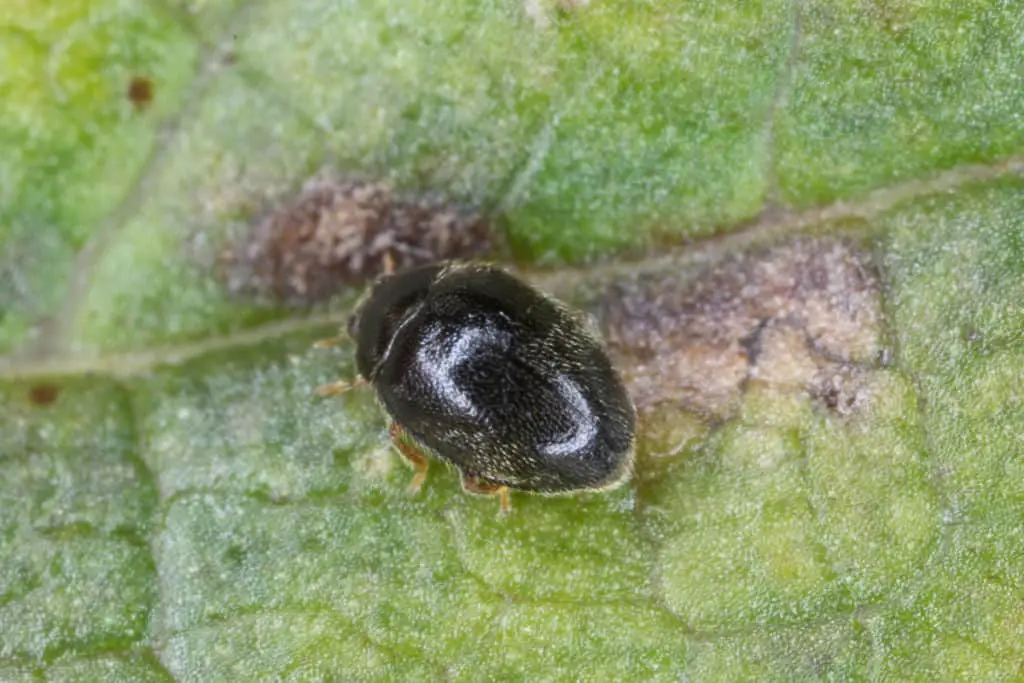
Spider Mites
Spider mites are worth special mention. The mites are a major issue in agriculture and if not controlled can wipe out entire crops.
Several kinds of spider mites are important pests to bedding plants, ornamental shrubs, and trees. However, under optimal conditions spider mites can populate rapidly and threaten plant health. Most commonly, they occur in red colors followed by the most notorious two-spotted spider mite which is found all over the world. Other spider mites species are green, yellow, and brown.
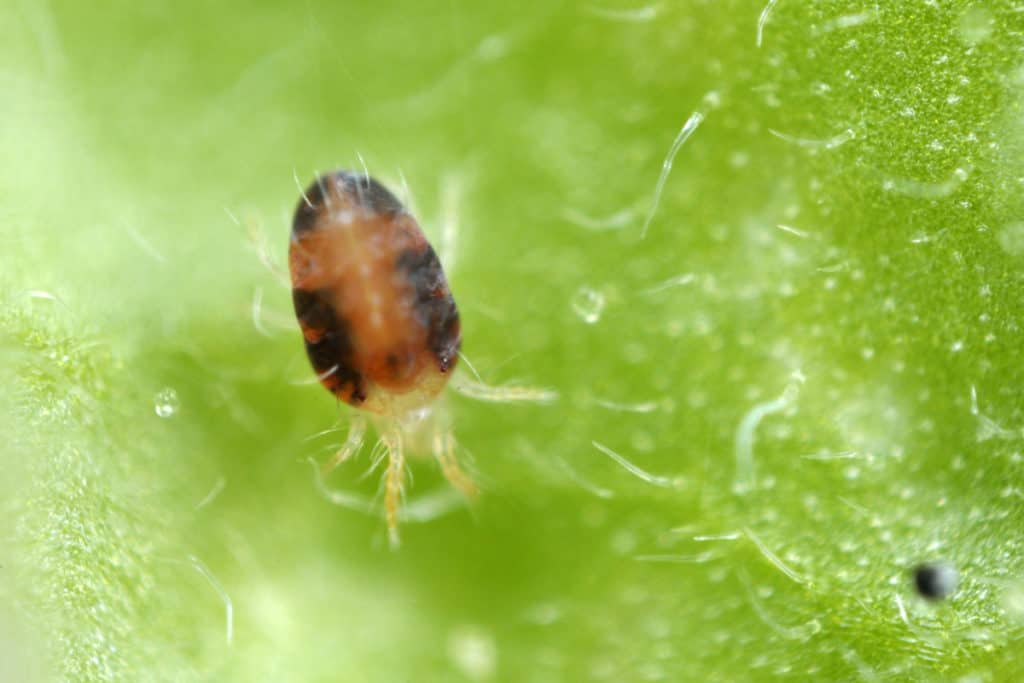
Spider mites are extremely small and appear as reddish or greenish spots on leaves and stems. They can be found in greenhouses and they also occur in tropical and temperate regions. They cause damage to plants by puncturing the plant cells to feed. They can be found on the underside of leaves and plants where they may spin silk webs to protect themselves.
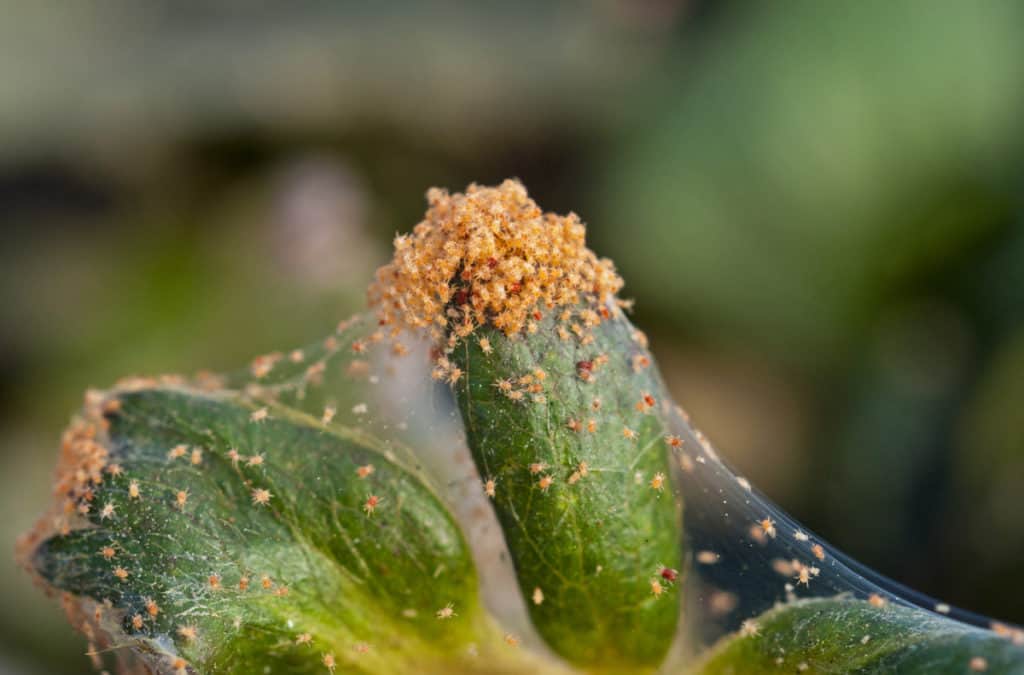
Feeding On: Mites
Stethorus is a genus of small black ladybugs that are specialized mite destroyers. This species is considered of significant importance to agriculture because they are natural predators of destructive pests such as spider mites.
Stethorus ladybugs are bred commercially for release onto crops to control pest mites. Suppliers recommend releasing 0.5 – 1 per 10 square feet. The adult stethorus need to eat 20 to 40 mites a day to maintain an egg-laying rate of 3 to 13 per day. The larvae of the stethorus will also feed on mites eating about 240 over about 10 to 14 days before pupating.
Adult stethorus also consume mites’ eggs, adding to their effectiveness in controlling pest mites earning them the “mite destroyer” title.
5. Eggs, Nymphs And Larvae
Eggs, nymphs, and small larvae are easy meals for ladybugs. The great thing about this is that ladybugs can help control pests that threaten both your vegetable garden and large commercial agricultural enterprises. The consumption of eggs or larvae breaks the life cycle of the pest.
The eggs need to be soft to be eaten by ladybugs. They need to bite through the egg with their mandibles to consume the nutrients inside.
Larvae and nymphs have to be very young, small enough for a ladybug to be able to grab and eat.
Here is a list of some of the insects that have their eggs consumed by ladybugs:
- Moths
- Butterflies
- European Corn borer – The larvae cause substantial crops losses annually in the United States.
- Colarado Potato Beetles – These guys are also a major pest in the United States
- Other Ladybugs
Here is a list of some of the insects that have their larvae and nymphs consumed by ladybugs:
- European Corn borer
- Moths
- Butterflies
- Very young nymphs
Destructive Ladybug Pest Species
Mexican Bean Beetle
The Mexican bean beetle can often be mistaken for a ladybug as they are similar in appearance, however, although both belong to the Coccinellidae family the Mexican bean beetle is a savage agricultural pest. Fortunately, our friends the predatory ladybugs can help control the Mexican bean beetle as they enjoy eating their eggs.
Legumes are a favorite food source for the Mexican bean beetle as the insects’ name suggests. The Mexican bean beetle prefers most varieties of snap beans and Lima beans. The group called wax beans is preferred slightly more than Lima beans. Host plants suffer a lot of damage from both adults and larvae of the Mexican bean beetle because it will feed on the flowers and the pods of beans.
Larvae feed on the underside of the leaves thereby causing the most damage by producing a lace-like, skeletonized appearance. Occasionally, blossoms and small pods will be destroyed. Being fairly strong fliers, adult beetles can travel long distances in search of fresh sources of beans to feed on.
Squash Beeltes
Squash beetles, as the name implies, feed on members of the squash family of plants. Feeding occurs primarily on leaves and stems, but the fruits may also be attacked. Adults and larvae feed on tissue leaving behind lace-like “skeletonized” leaves.
The plants in the squash family that are affected are squash’ pumpkin, zucchini, and gourds (some are inedible). Cucumbers, cantaloupe, and watermelon are also known to be hosts for squash beetles.
Innocuous Ladybug Species
Ladybugs Feeding On Mildews and Fungi
Innocuous species feed primarily on mildews and fungi. Halyziini tribe of ladybugs feed on fungal growths on the leaves of plants. They are common in Florida and the coastal areas all the way west to Louisiana.
The 24-spot ladybug, also known as the alfalfa ladybug does not eat aphids. It differs from other ladybugs in appearance because it is not shiny or smooth. It feeds mainly on fungi and molds that are found in alfalfa fields. Despite its name, the alfalfa ladybug does not actually eat the alfalfa.
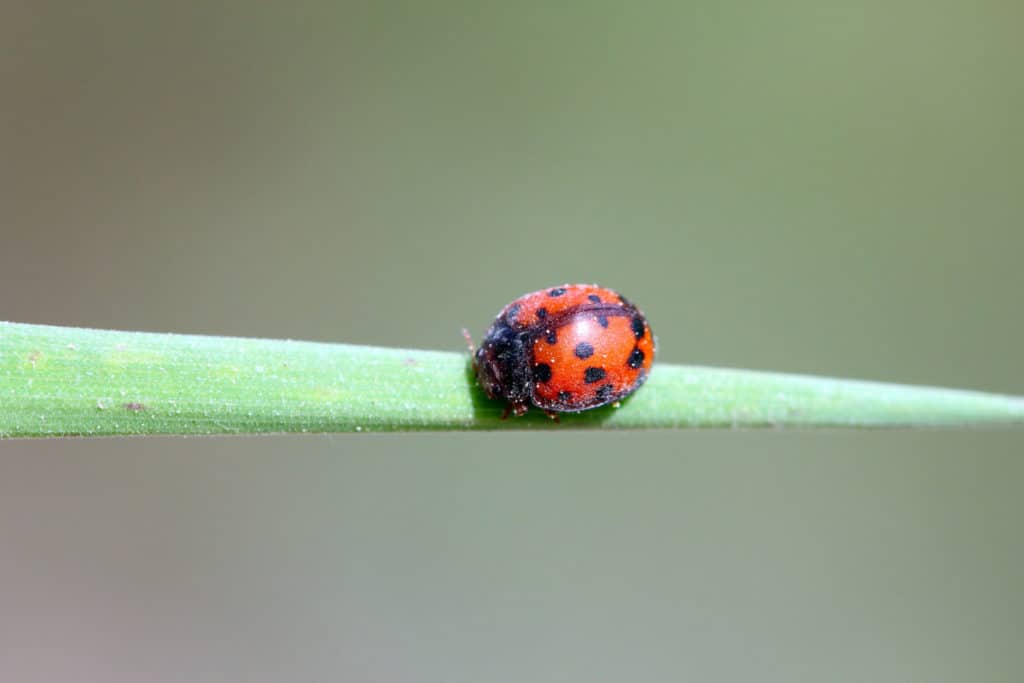
What Do Ladybugs Eat If Their Preferred Food Is Not Available?
In times of food scarcity, Ladybug larvae and adults may supplement their diet with other types of food. These include flower nectar, water, and honeydew. They also feed on extrafloral nectarines which can be found in many plant species. Plant nectarines are nutrient-laden secretions located in flowers and also occur on fruit, leaf laminae, petioles, stipules, or pedicels.
Other sources of food besides their favorite prey include pollen, plant sap, and various fungi. The pink spotted lady beetles Coleomegilla maculata, unlike most Ladybeetles, may eat up to 50% of pollen as part of their diet. Nonetheless, both adults and larvae are also important aphid predators. They also eat mites, small caterpillars, insect eggs, and small larvae.
Ladybugs Turing To Cannibalism
Frequent cases of cannibalism involve adults, older larval or nymphal stages turning on and eating juvenile stages or eggs. But ladybug larvae may also eat each other if their usual food sources are unavailable.
Ladybugs can also eat larvae and eggs of their own or other species. Some ladybug species lay many unfertilized eggs (trophic eggs) and may resort to eating some of them when faced with low food availability like scarcity of aphids.
The invasive Harlequin ladybugs species (Harmonia Axyridis) is a native of Japan and East Asia. As a bio-control agent introduced into America and Europe aimed at eating aphids, it has proved to be very effective. It has a varied diet and short breeding times, it has displayed an ability to adapt quickly to a different environment.
Harlequin ladybugs turn to cannibalism with both larvae and adults eating the eggs of their own kind when food is scarce.
What Do Ladybug Larvae Eat?
Many ladybug species lay their eggs in clusters directly in aphid and scale insect colonies in order to ensure their larvae have an abundant and immediate source of food. Ladybug larvae are voracious eaters of aphids and can eat up to 23 aphids a day.
Once pests get scarce, adults tend to move on while larvae remain and search for more prey. A Ladybug may eat up to 5000 aphids in its lifetime. Ladybug larvae have a spikey body that has an alligator-like appearance, but they are harmless to humans. The larvae pupate on a leaf after feeding on insect prey for several weeks.
What Do Ladybugs Eat In Winter?
Food resources are commonly not available during the winter period, especially in temperate regions. How ladybirds manage their energy reserves is crucial for the Insects to successfully overwinter. Ladybugs fatten up and build body mass during the seasons of plentiful food resources in readiness for the winter.
Ladybugs depend on stored body fat for energy to keep them alive during winter. When winter is over, starvation is a reality for ladybugs because their main aphid diet is not immediately available. They lose a lot of stored fat during winter.
The ladybugs overwinter in an aggregation which helps them to conserve body heat and they remain in a dormant state (diapause). In this state, metabolism rates are totally slowed down, but they are still dependent on temperature.
They don’t eat during this time. Whilst in diapause, which is a reversible state of very low activity with suppressed metabolism, ladybugs can still respond to environmental stimuli such as temperature changes. Activity such as feeding or reproduction can be renewed quickly.
However, coming out of diapause in a weakened state and without adequate food available, ladybugs as well as many other insects, can face starvation. At this point, they will have lost a substantial amount of fat through winter.
What Do You Feed Pet Ladybugs?
What you will feed pet ladybugs depends on the type you are keeping. Most ladybugs will eat aphids as their primary food. These tiny insects can be purchased at pet supply shops. However, regardless of the type of ladybug you are keeping, you can feed your ladybug moistened raisins or sweet non-acidic fruit. Ladybug diets can also include small insects, fungi, or fruit.
For more information specifically about what fruit ladybugs like to eat, check out the article we have written called, Do Ladybugs Eat Fruit?
Moisture is important for ladybugs. Ensure to keep the atmosphere in the pet box or terrarium moist. This can be done either by spraying or putting a damp paper towel inside. To provide water for the ladybugs or use a clean dampened sponge as a water source. Cotton balls dampened with water can also do the job.
Caution should be taken to avoid water dripping all over the enclosed ladybug’s house. Water should not be allowed to pool at the bottom of the enclosure because it can drown your ladybug. The cotton and sponge should be changed frequently to avoid bacterial growth. If they get smelly remove them. But don’t wait for that to happen. Aim to periodically change them whilst they are still relatively fresh.
Purchased food for ladybugs generally comes in powder form. Wheast is also a good food supplement that is available in pet shops but you can easily make it at home. Homemade wheast is a mix of equal parts of sugar or honey, yeast, and water. You can wipe or paint thicker wheast paste on wooden sticks and place it in the ladybug enclosure or dilute with water and spray on foliage.
Ladybirds need to eat aphids almost every day. Long-term indoor care will require a daily supply of aphids to feed the ladybugs. The insects that you feed ladybirds should be smaller than the ladybirds.
How Much Food Do Ladybugs Eat/Need To Eat?
We have seen that ladybirds feed primarily on aphids. On average, an adult ladybug can eat some 50 to 75 aphids each day. In its lifetime, it can consume up to 5000 aphids. Ladybugs eat what they require for nutrition depending on the availability of food and seasons.
In winter they don’t eat much because their bodies require little energy during hibernation when they are in diapause. In any case, food is not available during winter. Their metabolic rate slows down and growth is halted until the weather begins to warm up. However, they still need water even during winter and can be seen sipping from droplets of condensed moisture to stay hydrated and healthy.
Larvae are voracious feeders and can eat up to 23 aphids every day. Aphids are sedentary insects and are easy prey for ladybugs. Larvae usually eat more aphids than adults because they are most numerous because they hatch more or less at the same time. The adults fly off when food resources dwindle leaving the larvae to eat the available aphids.
For species that don’t eat aphids such as the Mexican bean beetle and Squash beetle, they will continue feeding and breeding for as long as their food is available. They will eat enough to sustain themselves and lay eggs. When food begins to get low, adults fly off to seek new sources of food.
Do Ladybugs Drink Water?
Ladybugs drink water. They find water sources from dew on plants, honeydew from aphids, or condensed moisture on smooth surfaces such as windows and walls. They need two to three drops of water a day to keep well hydrated. Even when in hibernation, they still need to drink water although they may not be eating because their metabolic rate is suppressed.
We actually have a whole article about this topic. If you are interested, it’s called, What do Ladybugs Drink?
How Long Can Ladybugs Survive Without Food?
As mentioned previously, ladybugs use up the stored fats for the winter cold season. This can last about eight to twenty weeks. After winter, if food is not available for the ladybugs to replenish their fat reserves, they will inevitably weaken, starve and eventually die.
If ladybugs aren’t wintering and they cannot access or find food, they will not live for more than two days. When active they need to eat copiously every day to keep up their energy levels. They tend to fly fairly long distances and expend loads of energy. They also lay many eggs, which requires constant consumption of food.
If you want to know more about all aspects influencing how long ladybugs could live, then look no further… We have another article with everything you need. The article is called, How Long Do Ladybugs Live?
The Wrap Up
Apart from making beautiful and colorful indoor and garden outdoor pets, ladybugs play a major role in our ecosystems. Farmers and experienced gardeners appreciate the benefits of ladybug populations in keeping pests such as aphids and mites under control.
Not all bugs that are found in the garden are pests! Nature tends to balance both the good and harmful insects in our environments. By killing some of them unwittingly, we may end up giving pests a chance to really establish themselves.
Some species of ladybugs have proven to be of great benefit as natural predators by feeding on crop pests. Others not so much because of the big losses they inflict on the agricultural industry. It’s of little wonder then that entomologists are constantly researching and battling to find bio-control agents in the form of beneficial insects to stem the problem.
Some species resort to cannibalism in hard times, which is part of the survival mechanism of ladybirds. Invasive species take over territories like an unstoppable army, sometimes at the expense of native species that are pushed out and decimated. This causes an imbalance in the insect ecosystem in those locations.
Our understanding of the Ladybugs’ food sources and preferences is going to be helpful in taking care of the ladybugs. These insects will in turn take care of a balance in our crop and garden ecosystems. A win-win situation.
Sources
https://biocontrol.entomology.cornell.edu/predators/Hippodamia.php
https://www.wikihow.com/Take-Care-of-a-Ladybug
https://www.nature.com/articles/s41598-020-61820-7
https://www.sciencedirect.com/topics/agricultural-and-biological-sciences/coccinellids
https://blogs.biomedcentral.comsciences%20descended%20from%20native%20populations.
https://edis.ifas.ufl.edu/ch195%20and%20edis.ifas.ufl.edu/mg005
https://www.sciencedirect.com/topics/agricultural-and-biological-sciences/colorado-potato-beetle
https://www.gardendesign.com/how-to/aphids.html
https://phys.org/news/2018-07-ladybug-aphid-fighters-tend-roam.html
https://www.planetnatural.com/pest-problem-solver/beneficial-insects/lady-beetles/
https://www.sciencedirect.com/topics/agricultural-and-biological-sciences/scale-insects
https://en.m.wikipedia.org/wiki/Whitefly
